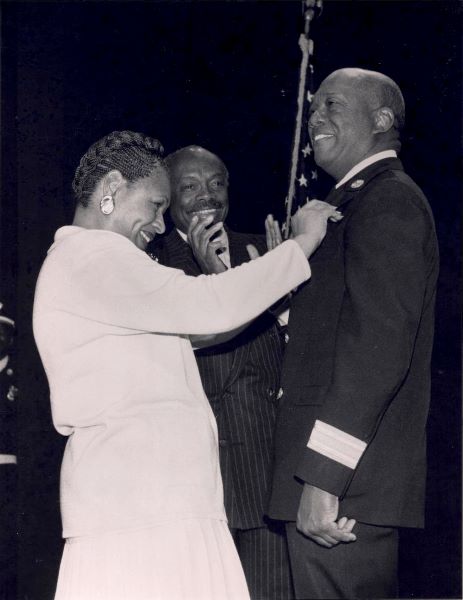Report on the Professional Designation of Chief Fire Officer Scott F. Wilkes
Introduction
On June 30, Chief Scott F. Wilkes, the Fort Lee operations fire chief, was awarded the professional designation of “Chief Fire Officer” (CFO) by the Commission on Professional Credentialing® (CPC). This achievement places Chief Wilkes among an elite group of 2,033 CFOs worldwide. This report details the significance of this designation, its rigorous requirements, and its direct alignment with several United Nations Sustainable Development Goals (SDGs), reflecting a commitment to building safer, more resilient, and sustainable communities.
Alignment with Sustainable Development Goals (SDGs)
The attainment of the CFO designation represents a significant contribution to advancing key SDGs through the enhancement of public safety and institutional excellence.
- SDG 11: Sustainable Cities and Communities: The core function of a highly qualified fire service is to make human settlements safe, resilient, and sustainable. The expertise signified by the CFO designation directly supports Target 11.5, which aims to significantly reduce the number of deaths and the economic losses caused by disasters. A professionally credentialed fire chief ensures robust emergency preparedness and response, which is fundamental to community resilience.
- SDG 3: Good Health and Well-being: By ensuring the highest standards in emergency services, credentialed fire officers play a critical role in protecting public health. Their work in fire prevention, emergency medical response, and hazard mitigation directly contributes to reducing mortality and injury rates from accidents and disasters.
- SDG 4: Quality Education: The CFO designation process embodies the principles of lifelong learning. It requires candidates to demonstrate extensive education and professional development and mandates a future development plan, reinforcing a culture of continuous improvement and knowledge acquisition within critical public safety institutions.
- SDG 16: Peace, Justice and Strong Institutions: The rigorous, transparent, and peer-reviewed credentialing process strengthens the fire service as an effective and accountable public institution. This commitment to professional excellence builds community trust and contributes to stable and well-governed societies.
- SDG 8: Decent Work and Economic Growth: Upholding high professional standards for fire officers promotes decent work within the public safety sector. Furthermore, effective fire services protect infrastructure, businesses, and homes, thereby safeguarding economic assets and supporting sustained economic growth.
The Chief Fire Officer Designation Process
A Comprehensive Evaluation Model
The CFO designation is a voluntary program administered by the CPC, an entity of the Center for Public Safety Excellence®. It utilizes a comprehensive peer-review model to validate an individual’s professional competence and commitment. The evaluation is based on seven key components.
- Experience
- Education
- Professional Development
- Professional Contributions
- Association Membership
- Community Involvement
- Technical Competence
Requirements for Maintaining Designation
The CFO designation is valid for a three-year period. To maintain the credential, recipients must demonstrate continued professional growth and adhere to a strict code of professional conduct. This requirement ensures that designees remain at the forefront of the profession, aligning with the principle of lifelong learning (SDG 4). Maintenance criteria include:
- Ongoing professional development activities.
- Active professional contributions.
- Sustained membership in relevant professional associations.
- Continued community involvement.
Conclusion: Institutional and Community Impact
The successful credentialing of Chief Wilkes serves as an organizational benchmark for excellence within Fort Lee’s emergency services. According to Lt. Col. Ronald Q. Holman, Fort Lee’s director of emergency services, this achievement is an inspiring example that reflects positively on the organization’s values and its commitment to public safety. By investing in professional development and adhering to international standards, the Fort Lee fire service strengthens its capacity to protect the community, thereby advancing the global objectives of creating sustainable, safe, and resilient environments for all.
Analysis of Sustainable Development Goals (SDGs) in the Article
1. Which SDGs are addressed or connected to the issues highlighted in the article?
- SDG 4: Quality Education – The article emphasizes professional development, education, and the acquisition of specialized skills.
- SDG 8: Decent Work and Economic Growth – The article discusses professional achievement, career commitment, and excellence in a specific employment sector.
- SDG 11: Sustainable Cities and Communities – The professionalization of fire and emergency services directly contributes to the safety and resilience of communities.
- SDG 16: Peace, Justice and Strong Institutions – The article describes a credentialing process that strengthens a key public safety institution through accountability and high standards.
2. What specific targets under those SDGs can be identified based on the article’s content?
- Target 4.4: By 2030, substantially increase the number of youth and adults who have relevant skills, including technical and vocational skills, for employment, decent jobs and entrepreneurship.
- Explanation: The article focuses on Chief Wilkes achieving the “Chief Fire Officer” designation, which is a high-level vocational credential. The program is designed to “recognize individuals who demonstrate their excellence in seven measured components including experience, education, professional development… and technical competence.” This directly aligns with increasing the number of adults with specialized skills for employment.
- Target 11.5: By 2030, significantly reduce the number of deaths and the number of people affected and substantially decrease the direct economic losses relative to global gross domestic product caused by disasters…
- Explanation: The article is about the head of a fire and emergency services organization achieving a high level of professional competence. Highly skilled and credentialed fire chiefs are essential for leading effective disaster response operations (e.g., fires, medical emergencies), which in turn makes the community (Fort Lee) safer and more resilient, directly contributing to the goal of reducing the impact of disasters.
- Target 16.6: Develop effective, accountable and transparent institutions at all levels.
- Explanation: The article describes the Commission on Professional Credentialing’s program, which uses a “comprehensive peer review model” and requires recipients to “adhere to a strict code of professional conduct.” This process builds a more effective and accountable fire service institution by ensuring its leadership meets rigorous, transparent, and internationally recognized standards.
3. Are there any indicators mentioned or implied in the article that can be used to measure progress towards the identified targets?
- For Target 4.4:
- Implied Indicator: The number of professionals who have successfully completed the credentialing process.
- Explanation: The article provides a specific number, stating that Chief Wilkes is “one of only 2,033 CFOs worldwide.” This figure serves as a direct measure of the number of adults who have achieved this specific high-level vocational skill.
- For Target 11.5:
- Implied Indicator: The existence of and number of leaders with advanced professional designations in emergency services.
- Explanation: The “Chief Fire Officer” designation itself is an indicator of a community’s capacity and preparedness for disaster response. While not a direct measure of reduced losses, it is a key input metric for institutional resilience. The article highlights that achieving this designation “reflects positively on the organization and its values.”
- For Target 16.6:
- Implied Indicator: The establishment and use of a formal, peer-reviewed credentialing system for public service officials.
- Explanation: The article details the existence of the “Commission on Professional Credentialing” and its program. The program’s components—”a comprehensive peer review model,” required “community involvement,” and adherence to a “strict code of professional conduct”—are all indicators of an accountable and effective institutional framework.
4. Summary Table of SDGs, Targets, and Indicators
| SDGs | Targets | Indicators (as identified in the article) |
|---|---|---|
| SDG 4: Quality Education | Target 4.4: Increase the number of adults with relevant technical and vocational skills for employment. | The number of individuals awarded the “Chief Fire Officer” designation (stated as 2,033 worldwide). |
| SDG 11: Sustainable Cities and Communities | Target 11.5: Significantly reduce deaths and economic losses from disasters. | The achievement of a professional designation by an emergency services leader, signifying a high level of community preparedness. |
| SDG 16: Peace, Justice and Strong Institutions | Target 16.6: Develop effective, accountable and transparent institutions. | The implementation of a credentialing system based on a “comprehensive peer review model” and a “strict code of professional conduct.” |
Source: army.mil







